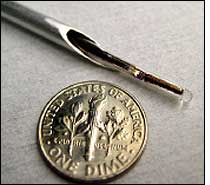Administering radiation to treat malignant tumors is not a precise science. Doctors have to direct radiation at the tumor while sparing the surrounding healthy cells from exposure and damage. But the conventional way to locate tumors—using a three-dimensional imaging system—is “not always perfect,” says Babak Ziaie, an associate professor at Purdue University’s School of Electrical and Computer Engineering and a researcher in the school’s Birck Nanotechnology Center. In addition, doctors must wait days or weeks to see if the treatment was effective. “The radiation dose is measured at the skin surface,” Ziaie says, “but that’s not the same amount of radiation the tumor receives.”
Ziaie was chatting with a colleague one day about how oncologists need a better way to track the location of—and radiation exposure to—cancerous tumors. What if, he asked, we inject an RFID tag into the tumor that acts as a radiation sensor to determine both tumor location and radiation exposure at the tumor site?

Ziaie and other researchers at Purdue developed an RFID tag based on microelectromechanical systems (MEMS) technology, which integrates mechanical elements, sensors, actuators and electronics on a silicon substrate. The small prototype tag—the size of a pin—comprises a resistor, conductor and capacitor. The tag’s capacitor reflects a change in charge when the tag is exposed to radiation. The tag reader, held next to the body and within 5 cm of the tag, detects the change in electrical charge, which represents the amount of radiation to which the tumor was exposed.
The current prototype tag can only measure radiation; it doesn’t provide location data. But Ziaie expects to have both radiation sensing and location functions built into a single tag by the end of 2009. He also believes they’ll be able to shrink the tag to the size of a grain of rice.
The RFID tag could help oncologists improve the effectiveness of radiation treatment while decreasing its debilitating side effects and the risk to healthy tissue. Ziaie says he hopes to test the current prototype on animals this year, and then put the final prototype into clinical trials beginning in 2010. The National Institutes of Health is funding his research.

